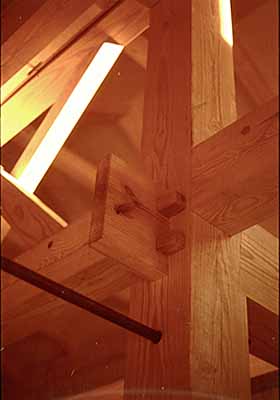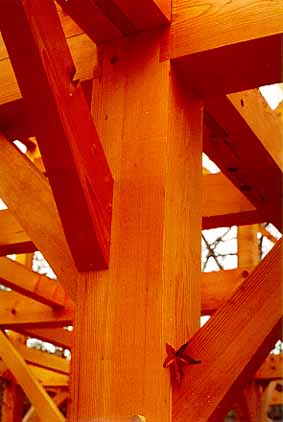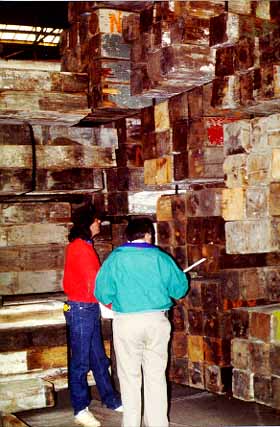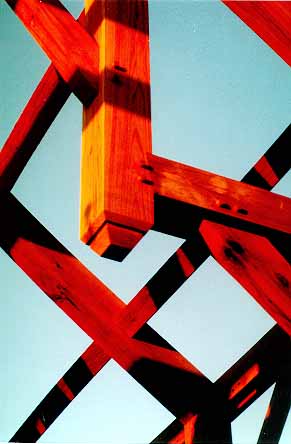|

|
There are many different types of wood that can be used in a timber frame and each
has its own working characteristics, strengths and beauty. Below is a discussion
of the types of wood found in timber frame construction and links to some examples
from our Home Galleries section.
|

|
Southern Yellow Pine (SYP)
Southern Yellow Pine is one of the premier structural woods in the world and it
is our most popular timber product. It is very stiff and, when dry, quite hard.
One of the colloquial names for SYP is "Hard Pine." It is available in
large sizes, long lengths and is of consistently high quality. It is also very amenable
to kiln drying so it need not be used green. When dried properly, it distorts very
little and checks are small and scattered. It has a bold grain pattern and a color
range from golden brown to reddish brown as it ages. It finishes and stains very
well. Southern Yellow Pine is a commercial classification for four related species
naturally occurring in the southeastern United States. The species are Longleaf,
Shortleaf, Loblolly and Slash pines. The mix of species changes as you move from
the Atlantic seaboard to East Texas. In our area Shortleaf and Loblolly are predominant
with a fairly substantial quantity of Longleaf in areas with sandy soils. The majority
of logs that we buy are Shortleaf Pine. See the award winning home we built in Livingston Texas for an example of a timber
frame using Southern Yellow Pine.
|

|
Douglas Fir
Douglas Fir, like Southern Yellow Pine, is one of the most sought after structural
woods in the world. It is available in virtually any grade and size. It has a very
pleasing dark reddish brown color as it ages. It is very sensitive to ultra violet
radiation and darkens very quickly when exposed to light. The grain pattern of high
quality Douglas Fir is often even in both color and pattern. Planed Douglas Fir
seems to glow when a clear oil finish is applied.
Douglas Fir, although very strong, has an Achilles Heel. It splits very easily along
the grain. It is therefore necessary to design joinery in such a way to avoid this
characteristic. This is seldom a problem for experienced timber framers. We kiln
dry new Douglas Fir before using it in a timber frame. Kiln drying stabilizes the
wood and reduces movement in the timbers and checking. Douglas Fir is one of the
more expensive woods on the market.
|

|
Recycled Douglas Fir
Although we use both new kiln dried and recycled Douglas Fir, recycled material
has its own special characteristics and beauty. In addition to the environmental
benefit of using recycle wood, the material is often very dry and stable. The nail
and bolt holes present often leave character marks that are pleasing evidence of
its previous use. Building with recycled material often gives the home a history
far older than its apparent age. Visit the home in
Argyle Texas to see an example of recycled Douglas Fir from Canada.
|

|
Red or White Oak
Oak is a relatively strong wood (not the strongest by any means), has a pleasing
grain pattern, takes a finish well and is easily worked when green and is moderately
priced. We have used it often. Both our Timber Shop and Planer Barn are Red Oak.
Most often Oak is used green, or freshly cut, which means it has a high moisture
content. As the wood dries, it checks and shrinks a great deal. This is unfortunate
in that both the joinery and timber faces distort after a frame is raised.
Since we are committed to using local materials, when Oak is a clients wood of choice,
we most often use the southern species of both Red and White Oak. Northern species
are available, but are in no way superior. Due to Red Oak's pleasing color, we most
often select Red Oak, although White Oak does offer better resistance to rot and
insect damage. This is only important if a frame will be subject to the elements,
as would a pavilion or possibly a barn.
Visit the home in Austin Texas for an example
of a Red Oak frame.
|

|
Cypress
Over the years we have used a limited amount of Cypress, mostly for pavilions and
porches. High quality Cypress is rot resistant, has a very pleasing color much like
Southern Pine but with a more subtle grain pattern. It often has very high moisture
content when green. In our experience it shrinks and checks relatively little as
it dries. On the down side, high quality Cypress logs are hard to find and are usually
quite expensive. They also tend to come from environmentally sensitive areas. Cypress
is not a particularly strong wood and prone, more than most woods, to ring shakes
(separation of the wood along the annual rings).
|
|